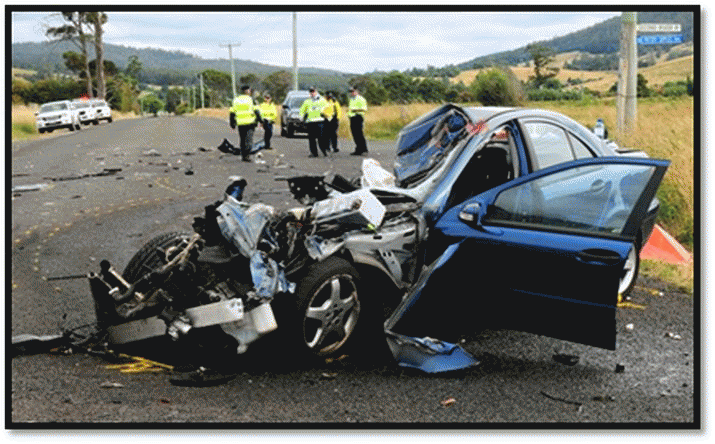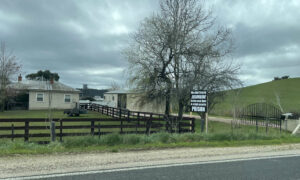*Pics: Hooning on Huon Road; Little policing for endangered species supports a one strike policy for hoons …
This article will review subsequent events and the current state of the Tasmanian Traffic Offences and Police Offences Acts in changing behaviours and as deterrents to dangerous driving.
In a previous article (
HERE ) I wrote, “It would seem Tasmania is getting some movement around our traffic laws and regulations. The Police Offences Act is not a deterrent in the eyes of our police. A spokesman for the government has highlighted the manslaughter charge as a serious offence and, by default, a better option than the current Traffic Offences penalty regime [in relation to the Sarah Paino fatality].” This was in response to an ABC news item on 24 January 2016,
PUSH FOR TOUGHER LAWS AFTER ALLEGEDLY SPEEDING TEENAGER KILLS PREGNANT WOMAN IN HOBART
Former Tasmanian policeman Phil Pyke said in Tasmania motor vehicle theft came under the Police Offences Act. He argues it should be dealt with under the criminal code. ‘It’s no deterrent at all with it remaining under the Police Offences Act,’ he said. Mr Pyke believes not changing the law is putting the public at risk.
It is a call echoed by the Police Association. President Pat Allen said the current laws were soft. ‘There doesn’t seem to be too many consequences at all, some sad events can happen rising out of motor vehicle accidents as we all know now,’ he said. ‘I think there are, amongst some sections of society, they have no conscience, they don’t care, they simply don’t care.’
http://www.abc.net.au/news/2016-01-24/push-for-tougher-laws-after-crash-kills-pregnant-woman/7110288
Aside from the direct opinion from the Police Association, Ivan Dean MLC also called for a review of “hooning laws” as being clearly inadequate,
HOONS COULD HAVE CARS CRUSHED UNDER PENALTIES PROPOSED BY TASMANIAN MLC
There are calls to toughen penalties for hoon drivers in Tasmania, including crushing vehicles of first-time offenders and making posting videos of illegal driving an offence. Independent MLC Ivan Dean called for the tough approach to first-time offenders, while the RACT wants vehicles of repeat offenders to be seized for longer periods.
He said he did not believe the existing anti-hooning laws introduced in 2009 were working. ‘[They are] far too lenient. Has it made a difference? No it hasn’t,’ he said. ‘If anything I think hooning’s reached new heights.’
His comments follow the discovery of a video posted on social media of a driver doing a burnout on the Tasman Bridge, one of Hobart’s busiest roads. ‘That sort of behaviour is not acceptable and we should have now one strike and you’re out,’ Mr Dean said.
It is worth noting Premier Hodgman’s response at the time,
Premier Will Hodgman said he believed Tasmania already has some of the strongest anti-hoon laws in place. ‘We have very strong anti-hooning laws here in Tasmania, stronger than in many other states,’ he said. We are actually able to seize the cars of those who repeatedly offend.’
http://www.abc.net.au/news/2016-02-03/hoons-could-have-cars-crushed-under-tasmanian-proposal/7137628?section=tas
Building on this clear advice has been a public petition as reported in the Mercury on 6 March 2016.
PUSH FOR SARAH’S LAW
Government ministers will meet this week to consider tougher penalties for stealing vehicles, police evasion and dangerous driving after 25,000 people signed a petition demanding change in the wake of the tragic death of Sarah Paino.
The Police Association of Tasmania also wants greater action, calling for vehicles to be seized for at least seven days and the crime of motor vehicle stealing to be elevated to the Criminal Code.
Police Minister Rene Hidding and Attorney-General Vanessa Goodwin will meet with their departments tomorrow.
The ministers will discuss proposals as a result of the “Sarah’s Law” petition, which appeals for “a change to Tasmanian law in relation to the crime of flee[ing] police”.Petition organiser Tanya Winn said she wanted to channel the public outpouring of anger on social media over the death of Ms Paino — the young, pregnant mother who died in the early hours of January 22 when an allegedly stolen 4WD crashed into her vehicle. It is alleged the 4WD had earlier been evading police on the Eastern Shore and was driving at high speed just ¬before the collision. The petition quotes Skye’s Law, which penalises those who deliberately try to avoid arrest by starting high-speed police chases. The NSW law is named after toddler Skye Sassine who was killed when a driver trying to evade police slammed into her parents’ car in 2009.
“Any deliberate act that ¬results in a death such as that which occurred in Hobart’s CBD at 1am on January 22, 2016, needs to be able to be dealt with by the police and the courts in a manner that will reflect the seriousness of the offence ¬regardless of the age of the ¬offenders,” the petition states.
It was delivered to Premier Will Hodgman, Labor leader Bryan Green, Greens leader Cassy O’Connor and the Road Safety Advisory Council on Thursday.
Authors Note: Also questionable are the reported responses from Tasmania’s legal fraternity and Road Safety Advisory Council. I will note, however, any review of the Traffic Offences and Police Acts would most likely result in less court time and the need for any subsequent legal representation thus diminishing their income earning potential,
Despite the petition’s public support, legal authorities say changing the laws is not the answer. Law Society of Tasmania president Matthew Verney said there was a community perception that the laws could in some way prevent offending behaviour. “That simply is not the case. It is the job of the criminal laws to deter certainly, but otherwise to punish offending,” he said. “The job of prevention falls to the need to educate, and change approaches to what is considered appropriate behaviour.”
Women’s Legal Service chief executive and principal lawyer Susan Fahey said the tragic event was reflected in the high number of people supporting the petition but the petition lacked clarity in the identification of the “problem”.
“If anything, it could lead to misinformation in the public as to what the law in Tasmania is and this is problematic,” she said.
Road Safety Advisory chairman Jim Cox said he totally understood that high numbers of people had signed the petition as a result of Ms Paino’s death.
“I have empathy and sympathy for them, but it is a ¬matter for the Government,” he said.
http://www.themercury.com.au/news/push-for-sarahs-law/news-story/042aa66882f50bbc8be2cf7f62945388
Despite Ministerial meetings and mixed messages from the Premier motor vehicle accidents continue to cause serious injuries and fatalities on Tasmania’s road network. A minority of drivers continue to drive without apparent concern for other road users and total disregard for traffic rules and regulations. The following ABC article on 20 March 2016 highlights current behaviours of drunk driving and speed,
TASMANIA POLICE CRACKS DOWN AROUND SORELL AFTER TWO HIGH-RANGE DUI CRASHES
Tasmanian police have said the actions of two high-range drink drivers involved in collisions that could easily have been fatal showed they had no regard for the safety of other road users. Both crashes happened at Sorell, south-east of Hobart, in the past fortnight.
In the first case, a 59-year-old man whose car collided head on with another on the Arthur Highway recorded a blood alcohol reading nearly six times the legal limit. An 82-year-old woman was seriously injured as a result.
The second crash happened at the intersection of Tasman Highway and Shark Point Road and left three people, including a seven-year-old boy in hospital. One of the drivers, a 26-year-old man, recorded a blood alcohol reading close to five times the legal limit.
Speed has also been identified as a factor in the crash, which saw one of the cars forced from the road, rolling and spinning at the same time. Police said both drivers had no regard for the safety of other road users or the rules, and their actions could have had fatal consequences. They said they were stepping up patrols, targeting drink drivers, in the Sorell area.
http://www.abc.net.au/news/2016-03-19/tasmania-police-to-crack-down-on-drink-driving-around-sorell/7259882?WT.ac=statenews_tas
What are the current offences and penalties in the Tasmanian Traffic Act?
1. Failing to wear a seatbelt
Driver or passenger (over 16) fail to wear properly adjusted and fastened seatbelt (when vehicle moving/stationary, but not parked)
$300 and 3 demerit points (except where the offence relates to the passenger)
This level of penalty is comparable with the new $319 fine for a cyclist not wearing a helmet.
2. Fail to stop as required on red traffic light
$140 and 3 demerit points
Using the same cycling comparison, while noting the differences in momentum and the cycling offence relating mostly to pedestrian crossings, the new NSW equivalent is a $425 fine. $140 is an inadequate level of penalty for a motor vehicle continuing through a red light.
3. Exceeding the Speed Limit by less than 10kph
Current: $80 and 2 demerit points.
Few fines are issued at this level except in school zones and the offence could be labeled an inadvertent error or genuine mistake. A fine around $150 would seem appropriate in 2016.
4. Exceeding the Speed Limit by 10 to 14 km/h
Current: $110 and 2 demerit points.
Most fines would fall within this speed range with a more suitable fine being around $250 and similar to not wearing a seatbelt.
5. Exceeding the Speed Limit by 15 to 22 km/h
$150 and 3 demerit points.
A typical example might be passing through a school zone at 60kph or passing a school bus without slowing.
6. Exceeding the Speed Limit by 23 to 29 km/h
Current: $250 and 3 demerit points.
Examples are now becoming more reckless where a car is travelling at up to 130kph in a 100 zone or 80 kph through a shopping zone. The level of fine is no longer relative to the level of the offence and should be around $650 and 5 demerit points.
7. Exceeding the Speed Limit by 30 to 37 km/h
Current: $450 and 5 demerit points.
A car is now travelling at up to 137kph in a 100 zone or 87 kph through a school zone. The level of fine is no longer anywhere near the level of the offence. This level could be merged with the previous category into “Exceeding the speed limit by 23 to 37km/h” or similar.
8. Exceeding the Speed Limit by 38 to 44 km/h
Current: $650 and 6 demerit points.
A car is now pushing 150kph in a 100 zone or over 100kph along a suburban road. The driver has passed from reckless endangerment to deliberate endangerment, in my opinion. The fine is considerably less than average weekly earnings. The fine should be at least $1,000 with an administrative variable applied by the police for aggravating circumstances like a second offence or hooning laws.
9. Exceeding the Speed Limit by 45 km/h or more
Current: $900 and 6 demerit points.
A car is now travelling in excess of 145kph in a 100 zone and the fine remains constant whether the speed is 150kph or 200kph. The driver is clearly engaging in deliberate endangerment. The fine has approached average weekly earnings and is manifestly inadequate. It should be around $3,000, an immediate loss of licence and confiscation of the vehicle.
10. Use or permit use of an unregistered motor vehicle
Current: $200 and no demerit points.
This is a growth area of non compliance in regional Tasmania where unroadworthy, unregistered and uninsured vehicles use our roads illegally. Again it is knowingly and deliberately non compliant. Currently, the average registration fees cost around $700 and a more appropriate level of fine would be at least $1,000 and the immediate confiscation of vehicle.
http://www.transport.tas.gov.au/licensing/publications/tasmanian_road_rules/road_safety_rules/new_offences_table
The levels of fines are clearly inadequate and are not tied to the CPI or any other annualised factor. Each is in need of urgent review. The speed classifications could be simplified into fewer categories. Administrative penalties (fines) should allow administratively imposed variables for reckless or deliberate actions. An internal avenue of appeal would provide natural justice. Confiscation of vehicles should be mandatory at the higher deliberate levels of offence such as exceeding the speed limit by 45kph or more, driving an unregistered vehicle or hooning). Court time should be minimized.
What are the Penalties for Driving under the influence of Alcohol or Drugs or other reckless behaviour?
Source: http://www.hobartlegal.org.au/tasmanian-law-handbook/crime/traffic-and-parking-offences/
Penalties Under the Road Safety (Alcohol & Drugs) Act 1970 Section 17
Range of penalties for first offence
Penalties, that is minimum and maximum Penalty Units, periods of disqualification and periods of imprisonment are doubled for second offences.
Author’s Note: Given the very high range DUIs being reported (over 0.2 and even 0.25) there is a need for even higher penalties. A new category should be considered for blood alcohol readings above 0.2 while mandatory sentencing should also be considered for being guilty of DUI and causing death or injury as Courts currently are too lenient with suspended sentences. Inadequate Court sentences may be with the deliberate understanding of government due to financial pressures in our prison system. Alternative punishments may need to be considered.
Reckless Driving
A person who drives recklessly or at a speed or in a manner which is dangerous to the public commits an offence and is liable for a penalty of up to 20 penalty units and/or imprisonment for 2 years for a first offence (s32(1), Traffic Act 1925 (Tas)). It is double this penalty for second or subsequent offences.
Driving While Disqualified
An offence will be committed if a person drives a motor vehicle on a public street or attempts to obtain a driver’s licence while disqualified, or while their licence is suspended or cancelled (s13, Vehicle and Traffic Act1999 (Tas)). For a first offence, a penalty of up to 40 penalty units will apply or up to 6 months in jail, plus a further period of disqualification of up to 3 years. For a second or subsequent offence the penalty is up to 80 penalty units, up to a year in jail and up to an extra 5 years disqualification.
Failure to Stop after an Accident
It is an offence for a driver to fail to stop after being involved in a motor accident (s33(1), Traffic Act). The driver must remain at the scene of the crash and give any assistance that is necessary or practicable. Failure to do so may involve a fine of up to 80 penalty points or up to 2 years jail.
Unlicensed Driver
It is an offence to drive a motor vehicle whilst unlicensed, and it is also an offence to permit an unlicensed person to drive (s8, Vehicle and Traffic Act). Penalty for first offence, up to a 20 penalty unit fine.
Offences Causing Death or Serious Injury
1. Manslaughter
A person who drives a motor vehicle in a criminally negligent way and causes the death of someone else may be charged and convicted of manslaughter (s156, Criminal Code Act 1924 (Tas)). A person in charge of a vehicle is under a duty to use reasonable care to avoid danger to human life (s150), and any breach of this duty that amounts to ‘culpable’ or ‘gross’ negligence will constitute manslaughter. This is a very high degree of negligence, much higher than the normal degree of negligence in civil matters. There must be pronounced disregard for the life and safety of others.
Manslaughter is a crime which must be tried before a jury, and the punishment may be a term of imprisonment up to a maximum of life imprisonment, but is usually in the range of 18-30 months. However, because in the past some juries were reluctant to convict drivers of manslaughter, the Criminal Code was amended to create a new offence of ‘causing death by dangerous driving’.
2. Causing Death by Dangerous Driving
This crime, along with manslaughter, is one of the few crimes where a ‘responsible citizen’ with no previous criminal record, if convicted, may be sent to jail. The crime involves causing death by driving a motor vehicle at a speed or in a manner that is dangerous to the public, having regard to all the circumstances of the case (s167A). The ‘public’ includes a passenger. Where a motor vehicle is driven on a public street, the nature, condition and use of the street, and the amount of traffic which is actually at the time, or which might reasonably be expected to be, on the street, is taken into account.
This crime is a statutory alternative to manslaughter and sentences are normally less than for manslaughter. Once the act of driving has been shown to be voluntary and intentional it is for the jury to decide whether the driving is objectively dangerous. The driver’s opinion on this point is irrelevant.
3. Reckless/Dangerous Driving
A person who drives dangerously, but does not kill anyone as a result, can be charged with ‘dangerous’ (or ‘reckless’) driving under the Traffic Act (s32(1)). In other respects, the offence is the same as causing death by dangerous driving. An accused can elect to have the charge tried by either a magistrate in the Magistrate’s Court or judge and jury in the Supreme Court.
4. Negligent Driving
A driver may also be charged with negligent driving under the Traffic Act (s32(2)). The manner of their driving in all the circumstances is examined to determine if the manner of driving has been negligent. It is a lesser offence than dangerous driving and the degree of negligence which must be proved will therefore be less. This charge is triable before a magistrate.
Footnote: A penalty unit is a fixed amount of money. Penalty units are used to decide the amount of a fine. The current penalty unit in Tasmania is $154. This means that if you are fined 2 penalty units, your fine will be $308. All fines are a multiple of a penalty unit.
A Complete Review of the Traffic Offences and Police Offences Acts is needed
The government has an opportunity to radically update and target the worst of driving behaviours through increased penalties related to the Traffic Offences and Police Offences Acts. Some offending drivers should be required to undertake psychological assessments as to their suitability to hold a licence while longer terms of disqualification (10 years to life) should be implemented. Mandatory loss of vehicle is another penalty option as is a ‘one strike’ policy for reckless driving like hooning or road rage.
The Police Association, too, is aware of the inadequacies of current penalties in deterring offences. In this day and age of electronic fund transfers there is no longer an excuse to ignore unpaid fines.
The claims by representatives of the legal fraternity to ‘increase public education’ for an ‘uncertain problem’ are as hollow and self interested as they sound. For Premier Hodgman, Minister Hidding and Attorney General Goodwin the time for action is now. The evidence has been available for many years and amending or implementing an Act of Parliament is in their job description.





























Stephan
March 27, 2016 at 10:37
Most of the more tragic accidents reported by the press would be avoided by changes to the Act, the imposition of greater penalties or the installation of saturation signage.
Testosterone fuelled youth don’t tend to read or care. People with medical conditions aren’t psychic and accidents, as they say, happen.
And many of the mature age drivers are sheep who seem to only care about themselves and not other road users. They’re so rigid in their road use they literally shatter in the event of a road emergency.
Yesterday I passed a newish Mitsubishi SUV happily holding up another vehicle and a police van at speeds between 60 and 70 in the 100 K zone tootling along the Huon Highway.
I long for the day of a speed range, rather than limit, and police can book people for being too slow as well as too fast.
Mickey Mouse
March 27, 2016 at 22:52
Fines are a joke not a deterrent. If we want to be serious then they should start at $500 for most offences. Would accept $200 for low range speeding (<10kmh over prescribed limit)
Points, you get 20 when you get your license and that's it. When their gone so is your license.
Driving without a license or unregistered vehicle. Vehicle crushed on road side and Bill sent to vehicle owner (not driver).
Using a mobile phone whilst driving, loss of phone on the spot. Phone is held for 14 days where owner can buy back otherwise it's destroyed.
DUI, minimum two year suspension of license and undergo drug rehabilitation with license only returned if driver can show they are clean.
Dangerous driving/hooning, vehicle confiscated and impounded for 30 days on first offence. Subsequent offences = vehicle crushed. If it's your bosses car then you have some explaining to do along with looking for a new job.
It's time people realised driving a vehicle is a privelidge not a right. If you want to drive right on the speed limit then expect infringements. If you want to talk on your mobile then expect to lose it.
Stephan
March 28, 2016 at 10:06
Wow
I bet you even lie straight in bed huh Mickey???
Extremist points of view are less than attractive even though they have their place in society.
Mickey Mouse
March 28, 2016 at 11:57
@Stephen, extremist? Nah, just time a few came to terms with there responsibilities and the fines associated fit with today’s salaries.
Don’t like it, don’t drive on the roads should be the way forward.
Pete Godfrey
March 28, 2016 at 12:45
I am not sure that heavier fines are the way to go. Most people who choose to break the law do it knowing that it is wrong. They just do not believe that they will get caught. Heavy fines don’t stop them doing it, because they aren’t the ones who are going to get caught (
their belief system).
Stephan maybe the vehicle you were following had an engine problem and could not go any faster, it does happen you know, when a car computer detects a fault is puts the car into Limp Home mode.
To me it comes down to whether you really need to get somewhere in such a hurry anyway.
I have seen many impatient drivers who get angry at others seemingly holding them up, only to pass the car then turn into their driveway within a few hundred metres. Now they may just be sending the offending slow driver a message but then they are putting others lives at risk by doing so. And what are they going to do with the time, unless they left the stove on or it is a medical emergency, a few seconds will not really affect them.
Remember life is quite short, why do we need to rush everywhere anyway. Maybe it is time to just enjoy the drive.
Stephan
March 28, 2016 at 16:38
Hi Pete (Post 5)
I understand all that and I am lately slowly joining the travel “comfortably” crowd. In a past life I ran to deadlines and used “systems”.
A road network with set speed limits is a system with predefined expectations. A regular percentage of road users have the network as their workplace, either maintenance, governance or delivery. For others the “privilege” of using the roads is an expectation set by the payment of taxes and registration fees.
The Traffic Act says that a motorist may travel up to a defined limit. Some people actually depend on speed limits in setting delivery time frames and expectations. Lives often depend on them. Some motorists don’t seem to care and willfully hold others up for any number of reasons, some good and some bad. Few do the polite thing and PULL THE FRIG OVER (where safely possible, not always easy on Tassie roads). I actually do and often find people looking at me strangely when I do.
So, yes, the motorist may have been limping home in their almost brand new SUV. Their passengers pointing at sites and holding what looked like cameras (Tassie plates). On a highway. With a police car and two other cars behind them and three others catching up fast.
It’s possible.
Just like all the people in the short term parking today were gonna drop in at the shops for 5 minutes but somehow got stuck and spent 30. It’s pretty convenient that short term parking is closer to the shops huh? There’s just no accounting for it when people look after their own interests to the exclusion of others.
Mickey Mouse
March 28, 2016 at 18:19
@5 Pete, it’s people as you describe that are a large part of the problem, attitude of drivers. The belief that a driver must do 100 in a 100 zone and everyone under that is holding them up is one that needs to be fixed.
You say you aren’t sure about heavier fines but what else will assist in the penny dropping for those that flaunt the law? I can assure you that someone faced with a minimum $500 (could be more) fine and forfeiture of their mobile phone will quickly abolish that unlawful act.
Today’s fines no longer cut it, $150 for exceeding the limit by 22kmh is not a minor oversight but $150 is not much more than a slab of beer and a four or five packets of cigarettes. Or a night out at the pub for a meal, drinks and 20 mins on the pokies is about the same. People can afford $150 an awful lot easier today than ten or twenty years ago when many of these fines were set.
People like Stephan are quite happy to roll along as is currently until their lives are turned upside down from a careless driver taking the law into their own hands. I lost my wife to a speeding driver a few years ago and my daughter is about to get her license. Let’s hope she dodges the bullet of someone who thinks they are capable to speed or using a phone whilst driving.
What I proposed above may seem extreme to some but what else is going to turn the attitudes of drivers around?
If someone else can suggest something then by all means share it.
Nagob Etats
March 28, 2016 at 18:31
Need more police on the road, not more fines.
On Monday afternoon there were fresh fishtails and circles on the road from Russell River through to Southwood Bridge, with bits of tyre rubber here and there.
Offenders were two kids in a white sedan, with a second light-coloured car accompanying them.
Couldn’t see number plates in all the dust but saw a tall light-haired skinny kid and a short dark-haired kid standing next to one car.
Car must have been stolen to be treated so bad.
There is currently a car wreck on Glen Huon Road and another up from Judds Creek on the North Huon Road. These wrecks seem to hang around an awfully long time before they are removed.
Mark Temby
March 28, 2016 at 19:13
Thanks for the comments to date. I do not see Mickey’s comments as extreme. In fact they are in line with some community research conducted by the Road Safety Advisory Council. The levels of fines in Tasmania are manifestly inadequate in relation to the seriousness of the offences, average incomes and interstate equivalents. Fines have obviously been lying dormant for decades without any annualised factor (eg CPI adjustments).
The current development of the Towards Zero Strategy by the Tasmanian Road Safety Advisory Council included an on-line survey. It provides a small window into community opinions, attitudes and beliefs. The first aspect highlighted addresses the likelihood of being caught where 72% believe it to be “unlikelyâ€:
“Respondents were also asked if they believed it would be likely they would be caught if they broke a road rule. The majority (42%) thought it fairly unlikely, with 30% believing it very unlikely. This is a high percentage of people who believe it possible to ‘get away with’ breaking the law.â€
The second aspect to be highlighted concerns over speed where:
“The majority of respondents (94%) indicated that they believed speed to be a factor in causing crashes – 68% also agreed that speed affects the outcome of a crash even if it is not the cause.â€
“When asked what is considered ‘speeding’ on a 50km/h road (using the report’s graphic display),
• 49% answered that driving 1-5km/h over the speed limit was speeding.
• 41% answered that driving 6-10km/h over the speed limit was speeding.
• 8% answered that driving 11-20km/h over the speed limit was speeding.
• 2% answered that driving >20km/h over the speed limit was speeding.
“These results were also very similar when asked what was considered ‘speeding’ on a 100km/h road.â€
Therefore, 90% of the respondents believed something less than 10kph over the speed limit was considered speeding. As for the question of revenue raising the report states:
“Some people believe that revenue raising is the main reason for targeting speeding motorists. When asked if they believed this was true, the majority of respondents (48%) answered ‘no’. 33% of people did believe this statement, with 19% being unsure. The community seems to be divided on this issue, perhaps indicating that there needs to be more education on why police patrol certain areas.â€
In conclusion, high percentages of people believe a speeding offence occurs at even low levels of excessive speed with little chance of being caught. Does anyone believe those who greatly exceed speed limits think any differently regarding being caught? This makes a debate on the levels of penalties a necessity if the government wishes to provide a real deterrent to excessive speed and inattention to the road conditions.
Stephan
March 28, 2016 at 19:53
Post 7 – Mickey
I’m sorry for your loss and a young lady, like your daughter, gushing on her mobile phone whilst returning from schoolies on the Gold Coast encouraged me to body slam the bitumen at 80kph and break a collar bone amongst other things some years back now. Humans are dangerous creatures.
So I trust you educate your daughter on these same dangers.
Mr Temby, sir, If stats, beliefs and desires became law we’d have no politicians, we’d all get paid huge sums of money and we’d be able to travel to work instantaneously, tra la la. And people wouldn’t lie, be selfish and treat others with respect.
What I do not see in your stats is the demographic and a lot of other very relevant supporting material that would go to the depth of the figures you present. “Believing” speed causes an accident is, to me, like believing Santa Claus exists. It is a supporting factor. Sometimes the primary one. But there are oh so many more causes to accidents.
Again, I spent two years in Qld Transport looking at accident reports in the 80’s and then , as now I expect, it was regularly a case of SMIDSY.
Just recently another parent lost their child reversing down a driveway. Very sad. This statistic, too, will be lumped in to the aggregate at the end of the year to prove that speeding is the root of all evil. Bullshit.
Pete Godfrey
March 28, 2016 at 20:22
Mickey Mouse #7 Sorry to hear about your loss. It does make it easier to understand where you are coming from so thankyou for sharing it.
I used to live in N.S.W, I remember when fines there went up hugely,in the 1990s or earlier the fine for driving an unregistered car was around $1000. There was a fine of $350 for each offence of Unregistered, Uninsured and Number Plates designed to deceive. Often on long weekends up there the fines are doubled and so are the demerit points, I have seen signs on freeways warning of fines of up to $950 for speeding. I don’t think it changed many peoples driving habits though.
I am sure that there would be way of educating people not to be so selfish, but that would go against the modern trend of people becoming more selfish, self centred and just plain rude.
Somehow we need to teach people that life is for living not speeding through.
Mark Temby
March 28, 2016 at 21:25
Stephan, beliefs and opinions are my words and they recognise very few facts exist in life including your opinions. I am not going to transcribe the entire RSAC report into this thread but the demographics broadly indicated (from memory) about 18% motorcyclists; about 60%+ male; around 45% in the workforce; and about 350 respondents statewide. BTW, they are not “my statistics” and numbers in excess of 72-90% are more than inconsequential figures. I’m sure your accident reports in Queensland a few decades ago were also viewed statistically to present a summary view.
Mark Temby
March 29, 2016 at 11:01
Although general in nature with no direct reference to road fatalities apart from a “Drink Driving Court†there has been a recognition suspended sentences have not worked in reducing serious crime. It is also acknowledged Tasmania’s lack of prison terms is out of step with interstate comparisons and the cost factor has been a factor in the thinking of the Tasmanian governments of recent years. It seems the AG Goodwin and the Hodgman government is timely in starting down the long road of reform. I await a considered and holistic response on Traffic Offences and Police Offences legislation.
ABC News:
“Suspended sentencing should be abolished in Tasmania: report
“Convicted criminals in Tasmania could be given home detention, with suspended sentences abolished over the next five years under recommendations from the Sentencing Advisor Council (SAC).
“The council’s proposed new system would allow judges and magistrates to impose Community Correction Orders (CCOs) as an ‘intermediate sentencing option’ for up to three years.
“Special conditions would be attached to reduce the likelihood of a person re-offending. The conditions would include education programs, assessment and treatment for alcohol or drug dependency, a maximum of 240 hours of community service, judicial monitoring and a curfew.
“Plan could cost at least $30 million. The SAC estimated it would cost the State Government almost $51 million to replace fully suspended sentences with equivalent prison terms.
The report said the cost would be $20 million less if the alternatives were CCOs, fines, imprisonment, home detention and treatment orders, depending on the type of offence.
“Figures released by the SAC show almost 38 per cent of offenders in Tasmania’s Supreme Court received a fully suspended sentence in 2013/14, when the national average was about 17 per cent. The disparity is similar in the Magistrates Court.”
http://www.abc.net.au/news/2016-03-30/suspended-sentencing-abolished-over-5-years-report-says/7283298?section=tas
Mercury News:
“TASMANIA’S get out-of-jail free card will be cancelled under controversial plans to start scrapping suspended prison sentences this year.
“Under the State Government’s ‘tough on crime’ election promise, serious sex offenders, drug traffickers and violent criminals can expect to do hard time from 2017.
In an interview with the Mercury yesterday, “Tasmania’s Attorney-General Vanessa Goodwin outlined the Hodgman Government’s most wide-ranging law and order Âreforms to date.
“Suspended sentences will be phased out over five years and coincide with new punishment options for the courts.
“The new measures include:
AXING suspended sentences for serious crimes.
INTRODUCING home detÂention, community correction orders, deferred sentences and fines without convictions.
ESTABLISHING a drink-driving court if recommended.
FAMILY violence offenders could lose eligibility for suspended sentences.
SEPARATE legislation to scrap suspended sentences for assaults on police, paramedics and firefighters.
CRIMINALS who breach suspended prison terms will also be banned from receiving them again for the offence.”
http://www.themercury.com.au/news/scales-of-justice/suspended-jail-terms-face-axe-for-serious-crimes/news-story/5d5c7cd60003ecc4a4f7c05ce00c95c4
Robin Charles Halton
March 30, 2016 at 01:45
Be aware the University year has begun, as I observed an influx of Asian students driving older model cars in the Sandy Bay area in a manner that many are obviously inexperienced drivers being let loose with International licences without proper accountability.
I did note one responsible Asian adult driving with a young Asian L plater, that is how it should be.
One young Asian lad in a early model Lexus did not have clue which way to turn the steering wheel to correct his parking position in the busy Woolworths car park.
A young Asian lady seemed to be having trouble
establishing the T bar position of foward and reverse close to many parked cars and pedestrians in the Coles Car Park.
Elderly folk and mothers with young children should be cautious keeping well clear of Asian students in car parks with older model cars.
TV Resident
March 30, 2016 at 18:40
I am inclined to agree with Mickey Mouse in comment 2.
While coming back from a trip to Ross on Easter Monday, a red car overtook my son and another car that was in front of us by cutting over a double white line and there was a van coming in the other direction very close. We couldn’t get the number as he was speeding, probably in the vicinity of 130kmh to 140kmh. My son was driving and he watched the same car perform the same daredevil stunts twice more with oncoming traffic very close. We arrived back in Launceston and luckily we didn’t see this car smashed into another. Nor did we see ANY police on the way down to Ross or coming back home.
Mel
March 31, 2016 at 01:33
I find recent vehicle collision reporting by Examiner staff, namely a xxx xxx, to be most offensive, callous and despicable. Note the opening paragraph of this article – http://www.examiner.com.au/story/3817328/motorcyclist-in-serious-road-crash/?cs=95. Errors are made and there are significant consequences, but for the ghoulish insensitive scribbling of an obviously immature and detached person to be allowed to be published in this fashion indicates our society promotes sensationalism above care and concern for parties involved in such a mishap. I am ashamed to live in a provincial city where a reporter is able to produce such poor taste, and get away with it.
(edited)
Peter Bright
March 31, 2016 at 11:22
The kinetic energy of a moving body is proportional to the square of its velocity. This energy is dissipated on impact and so it would seem appropriate that speeding fines be figured accordingly.
Thus a 1% over-the-limit detected speed would incur a 2% addition to the listed penalty, with further examples as follows:
2% —> 4%
5% —> 10%
10% –> 21%
15% –> 32%
20% –> 44%
25% –> 56%
30% –> 69%
35% –> 82%
40% –> 96%
45% –> 103%
50% –> 125%
60% –> 156%
70% –> 189%
80% –> 224%
100% -> 300%
.. thus penalty doubling would be incurred at just 41% over the listed speed limit and penalty tripling would be incurred at twice that limit.
But considering the potential ramifications of excessive speed, or more correctly the potential for the consequences of a sudden stop when it is terminated, it seems to me that the square law above might not be a sufficient deterrent.
Instead of the square-law characteristic above a cubic law could be imposed, thus a driver haring along at twice the listed speed limit would incur [i]eight[/i] times the reference penalty because 2 cubed = 8.
I think the authorities would like this better, particularly if the exponent could be varied between say 2 and 3 according to road conditions and other relevant factors, with suitably coloured roadside speeding signs telling drivers just what they could be in for.